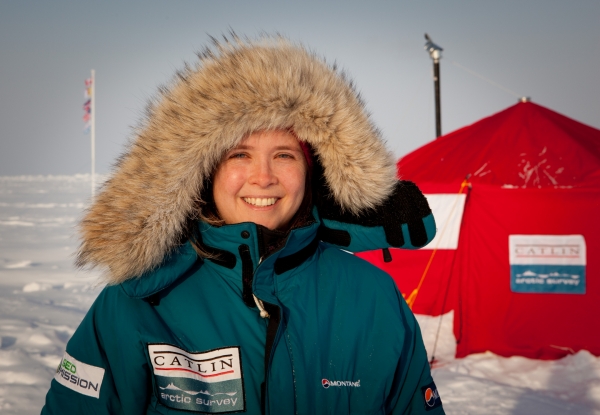Follow Researcher Victoria Hill's 'Outreach' from the Arctic
March 05, 2014
Victoria Hill is young enough to be mistaken for a student, but the assistant research professor in the Department of Ocean, Earth and Atmospheric Sciences (OEAS) at Old Dominion University is also one of the institution's most seasoned Arctic Circle researchers. Her work in recent years has focused on conditions that promote the melting of sea ice in the Arctic.
Hill also is well versed in science outreach aimed at children and teenagers, and she is giving her young audience the opportunity to practically travel along with her "in her suitcase" for the expedition to the frozen north that she began this week.
A member of the ODU Bio-optical Research Group (BORG) led by OEAS Professor Richard Zimmerman, Hill began her outreach for this expedition by starring in a video she titled "Packing for the Arctic" (http://www.youtube.com/watch?v=V0WnDV6mKNw). In it, she shows what she put in her suitcase to help her stay warm near the North Pole.
She will be reporting about the expedition at the BORG website (www.borgodu.com) and on the BORG Facebook page.
Together with Jenifer Alonzo, an ODU assistant professor of communication and theatre arts, Hill also will be participating in a dialogue with schoolchildren in Hampton Roads via the ODU Science Alliance Live website (sciencealliancelive.org). Alonzo, the creative force behind Science Alliance Live, has worked with Hill and other ODU scientists since 2011 in producing stage plays, artful demonstrations and the website to make climate science interesting to young people.
"While I'm away, Jenifer will be spinning up the Science Alliance Live website and encouraging local children to send questions that I can answer via Twitter. I will also continue to post video blogs," Hill said on Wednesday, March 5, the day of her departure.
Hill, who will be traveling with Zimmerman for the expedition, goes first to Barrow, Alaska. Their central chore is to deploy ice-tethered buoys that will support a string of sensors both within sea ice and in the water column underneath the ice.
The research, which is funded by the National Science Foundation Office of Polar Programs, centers on the hypothesis that the absorption of solar energy is having a significant impact on warming in the Arctic, and that this impact is not fully incorporated into computer models that aim to measure the thickness of sea ice.
Hill's research in recent years has targeted colored dissolved organic material (CDOM) that might be in higher concentrations than previously though in Arctic waters, and causing more absorption of heat.
"We think that the amount of light penetration and the absorption of that light right beneath the sea ice could be critical to improving scientists' understanding of the recent rapid sea ice melt and retreat in the Arctic," Hill said.
"The buoy is called WARM for Warming and iRadiance Measurements," she said with a chuckle, noting the irony of the moniker. "The data will be sent back to me via satellite, so I get to sit in my comfy office while the data roll in."
From Barrow, the researchers will travel by helicopter about 150 miles out to sea and land on ice for the first buoy deployment. Another buoy will be deployed later at Barneo, the Russian North Pole camp. Their stay for this leg in Barrow will be 10 days. <br>


